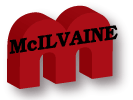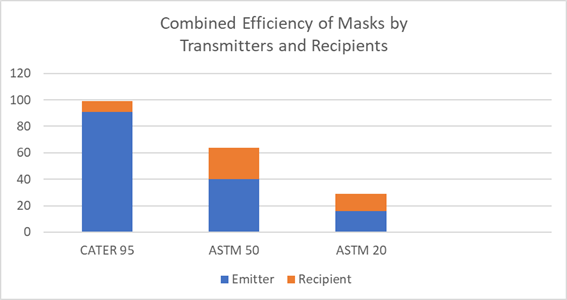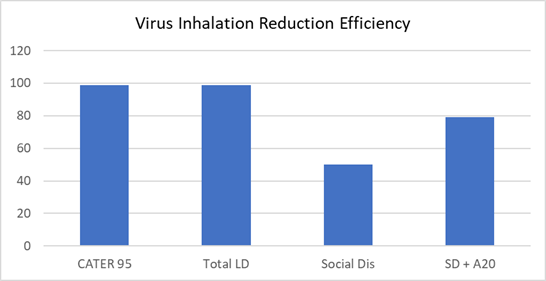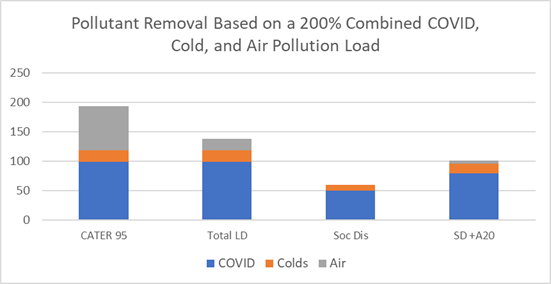
CATER Mask
Decisions
December 18, 2020
The Foundation of COVID
Mitigation Strategy Should be
Mask Effectiveness
Cummins is Making Masks with
Uniquely Charged Meltblowns
BelEmsa
Producing 200 Million
Masks per Month
H+V will
Expand
to 100
Million Mask Equivalents
per
Year
___________________________________________________________________________
The Foundation of COVID
Mitigation Strategy Should be
Mask Effectiveness
The strategy to defeat COVID
should be based on use of highly
efficient masks. All other
options are more costly and less
effective with the exception of
total lockdowns. The virus
spread with near normal activity
but correct use of CATER 95
masks will be less than if there
is a partial lockdown and use of
ASTM 20 masks.
The strategy which treats all
masks as equal makes little
sense. It is the equivalent of
saying that whether a room has
one occupant or 100 the risks
are the same. In fact if all
occupants are wearing CATER 95
masks the risk is equivalent to
the room with one unmasked
occupant. If every one of the
100 people is wearing
an ASTM 20 mask you have
the equivalent of 71 unmasked
people. This 70 to 1 ratio means
that mask efficiency should be
the cornerstone of COVID policy.
The following examples were
calculated based on available
information for various types of
masks. The net efficiency equals
the media efficiency less leaks.
|
Mask |
Efficiency % |
Leaks % |
Net Efficiency % |
|
CATER 99 |
99 |
-4 |
95 |
|
CATER 95 |
95 |
-4 |
91 |
|
CATER 93 |
93 |
-4 |
89 |
|
ASTM 50 |
50 |
-20 |
40 |
|
ASTM 20 |
20 |
-20 |
16 |
The leaks are derived from fit
testing and cannot be precisely
quantified in a given case. One
comprehensive set of tests with
a CATER 95 masks showed leakage
between 2 and 8 %. The actual
leakage depends on the face, the
mask dimensions and
construction. Where suppliers
can show a range of mask sizes
and extensive testing under
various motion conditions a low
leakage level can be assessed.
In the case of the upcoming ASTM
standards the leakage
declaration is left to the
manufacturer with little
assurance that low leakage will
be achieved in any specific
situation.
Masks are worn by the both the
transmitter and the recipient.
So the total virus inhaled
becomes a function of the
removal in the two sets of
masks.
|
Virus Penetration as a Percent of Total Load |
||||
|
Mask Type |
Location |
CATER 95 |
ASTM 50 |
ASTM 20 |
|
Virus Leaks |
Emitter |
4 |
20 |
20 |
|
Virus Penetration |
Emitter
|
5 |
40 |
64 |
|
Total Virus Emission |
Emitter |
9 |
60 |
84 |
|
Virus Leaks |
Recipient |
0.36 |
12 |
17 |
|
Virus Penetration |
Recipient |
0.45 |
24 |
54 |
|
Total Virus Inhaled |
Recipient |
0.85 |
36 |
71 |
The CATER 95 mask is therefore
71 times more effective at
preventing virus inhalation than
is an ASTM 20 mask. Granted that
fitness and other variables are
not precisely quantified but
this is a reasonable comparison.
Another approach is to compare
combined efficiency.

If
the decision is made on a basis
of comparative efficiency it is
easy to argue that a less
efficient mask is better than
nothing. At least an ASTM 20
will remove 29% of the virus if
worn by all.
But when you consider
that it allows 71 times as much
virus to penetrate as does a
CATER 95 mask this is a powerful
metric and one that can be used
in a total plan which includes
social distancing, HVAC, and
lockdowns.
The selection of more efficient
masks can be viewed from the
perspective of resumption of
more normal behavior.

Rigorous Social distancing
including prevention of large
gatherings could have an effect
of reducing virus inhalation by
40%.
If partial lockdown is
combined with ASTM 20 masks a
total reduction of 79% might be
achieved. It could be argued
that if everyone wore CATER 95
mask you could eliminate most
social distancing. In the case
of bars fan filter units and
directional air flow would be
needed because of the need to
remove masks while drinking or
eating.
The
value of CATER 95 masks is even
greater compared to alternatives
when you consider that air
pollution, wildfires and other
air contaminants are equally
important. Hypothetically let’s
assume a total load which is
200% of the COVID. So the COVID
load could equal 50% of the
contamination (100), colds and
other virus related infections
are 10% (20) and air pollutants
and other air contaminants are
40% (80).
The graph then reflects a
total contaminant load of 200

It is clear that the benefit of
CATER 95 masks is far superior
to the alternatives when all
pollutants are considered.
Social distancing does not
reduce the amount of air
pollutants inhaled.
Mask efficiency should be the
basis of all the social
distancing, lockdowns, school,
bar and
restaurant openings. If
everyone wears a highly
efficient mask there will be the
ability to return to near normal
activities while reducing the
COVID spread.
Ignoring mask efficiency is as
illogical as saying social
distancing of one foot or one
mile should be treated equally.
The mask protection has been
proven in every pandemic.
Doctors were kept safe from
EBOLA by wearing masks and
taking other protections. The
highly efficient masks
provided the 99 % protection but
other PPE assured that the
protection was 99.9999%.
It is recommended that we
immediately change our strategy
and consider mask effectiveness
as the foundation of any
program.
Cummins is Making Masks with
Uniquely Charged Meltblowns
Cummins is making material for
millions of face masks out of
its Cookeville, TN, filtration
plant — thanks to a partnership
with the U.S. Department of
Energy’s Oak Ridge National
Laboratory nearby.
“Because of our expertise in the
automotive filtration industry,
we believed we could adapt to
supply the filter media used in
the face masks worn by
healthcare providers, which are
also in high demand across the
nation,” Christopher Holm,
director of filter media
technology and IP at Cummins,
said in a news release posted
yesterday.
Oak Ridge’s Carbon Fiber
Technology Facility meanwhile
worked with Peter Tsai, the
inventor of N95 filter media, to
develop a novel in-line charging
device that could be placed on
the precursor production line to
electrostatically charge
melt-blown material made of
polypropylene or PP.
Electrostatically charging the
material with millions of
microfibers layered on top of
each other creates a filter
material able to remove more
than 95% of submicron particles
and viruses such as the one that
causes COVID-19.
“We reached our target goal in
only a few weeks on pilot scale
melt blowing capability at the
CFTF and had the capability to
produce filter media for 9,000
masks per hour when we connected
with Cummins for potential
technology transfer and scale
up,” said Merlin Theodore,
director of the CFTF at Oak
Ridge. “Cummins was an ideal
partner to scale what we had
accomplished and helped us
produce material that passed all
required testing for filter
media.”
ORNL’s research team designed
and manufactured a custom
electrostatic charging device
for Cummins, assisting in the
installation of the device on
the company’s Cookeville
facility production line.
“Their research has made it
possible to be where we are
today,” Holm said. “We can
manufacture material that has
passed all the required testing
for N95 filter media.”
Two months ago, Cummins had
never produced filter media for
face masks. Today, it’s already
shipped material to multiple
customers across the country for
the production of millions of
masks.
BelEmsa Producing 200 Million
Masks per Month
BelEmsa, one of the leading
manufacturers of disposable
hygienic products, has increased
mask production to 200 million
pieces per month in Europe,
according to Aleksandr Kolesnov,
the first deputy director of
BelEmsa in an article in
Nonwovens Industry.
In the fight against the novel
coronavirus, medical masks are a
vital item for healthcare
workers on the frontline.
Kolesnov states, “We are fully
aware that access to PPE is
challenging and we must secure
the production of such an
important item to encourage
business organizations and
public health through the
recovery period.”
Detailed research on face masks
have been conducted by the
BelEmsa R&D project team since
the beginning of the Covid-19
outbreak, Kolesnov adds. “We
were aware that performance and
comfort requirements must be
offered under hygienic
conditions due to public needs.
We applied extensive know-how
accumulated through our
experience and created soft ear
loop masks for perfect fit and
comfortable use. Meanwhile,
BelEmsa worked closely with EC
accredited laboratories and
German Federal Institute for
Drugs and Medical Devices (BfArM)
for manufacturing facilities at
European standards.
"We risk significant amount of
funds and invested millions in
machinery, raw materials,
hundreds of new employees and
factory space to manufacture an
item projected to have a
short-lived demand. However,
contributing to society has
become one of our key priorities
under the current
circumstances,” he continues.
According to Kolesnov, BelEmsa
has never experienced challenges
in nonwoven materials, logistics
and other key equipment thanks
to its long standing experience
and reputation in the hygiene
industry. He adds, “We have
always been a reliable partner
to the governments and
healthcare institutions to
ensure high-quality medical
products."
Kolesnov ends, “I’m proud of the
fantastic efforts of our
operational team who took our
business out of China and
brought to home. BelEmsa become
the first company producing what
it says is a unique comfortable
ear loop mask in Europe and
offering this innovative item
with the Senso Med brand since
June.”
H+V will Expand to 100 Million
Mask Equivalents per Year
The Department of Defense (DOD),
in coordination with the
Department of Health and Human
Services (HHS), has awarded a
$2.5 million contract to
nonwovens manufacturer
Hollingsworth & Vose, to
increase domestic production
capability of filter media.
This industrial base expansion
effort will allow Hollingsworth
& Vose to increase production
capacity to 100 million mask
equivalents per year in Floyd,
VA by October 2021, to support
the production of filter media.
The DOD’s Defense Assisted
Acquisition Cell led this effort
in coordination with the
Department of the Air Force’s
Acquisition COVID-19 Task Force.
This effort, funded through the
HHS Coronavirus Aid, Relief and
Economic Security (CARES) Act,
supports domestic industrial
base expansion for critical
medical resources.
